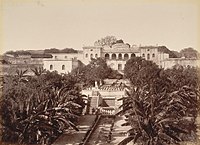#Explored_Aurangabad










Aurangabad is a city in Maharashtra state, in India. It’s known for the 17th-century marble Bibi ka Maqbara shrine, styled on the Taj Mahal. The nearby Shivaji Maharaj Museum, dedicated to the Maratha king Shivaji, displays war weapons and a coin collection. North of the city, the Aurangabad Caves comprise ancient, rock-cut Buddhist shrines. West of the city, battlements surround the medieval Daulatabad Fort.
Paithan, the imperial capital of the Satavahana dynasty (1st century BCE–2nd century CE), as well as Daulatabad or Dēvagirī, the capital of the Yadava dynasty (9th century CE–14th century CE), are located within the limits of modern Aurangabad. In 1308, the region was annexed by the Delhi Sultanate during the rule of Sultan Alauddin Khalji. In 1327, the capital of the Delhi Sultanate was shifted from Delhi to Daulatabad (in present-day Aurangabad) during the rule of Sultan Muhammad bin Tughluq, who ordered a mass migration of Delhi's population to Daulatabad. However, Muhammad bin Tughluq reversed his decision in 1334 and the capital was shifted back to Delhi. In 1499, Daulatabad became a part of the Ahmadnagar Sultanate. In 1610, a new city named Khaḍkī was established at the location of modern Aurangabad to serve as the capital of the Ahmadnagar Sultanate by the Ethiopian military leader Malik Ambar, who was brought to India as a slave but rose to become a popular Prime Minister of the Ahmadnagar Sultanate. Malik Ambar was succeeded by his son Fateh Khan, who changed the name of the city to Fatehnagar. In 1636, Aurangzeb, who was then the Mughal viceroy of the Deccan region, annexed the city into the Mughal Empire. In 1653, Aurangzeb renamed the city as "Aurangabad" and made it the capital of the Deccan region of the Mughal Empire. In 1724, the Mughal governor of the Deccan, Nizam Asaf Jah I, seceded from the Mughal Empire and founded his own Asaf Jahi dynasty. The dynasty established the State of Hyderabad with their capital initially at Aurangabad, until they transferred their capital to the city of Hyderabad in 1763. Hyderabad State became a princely state during the British Raj, and remained so for 150 years (1798–1948). Until 1956, Aurangabad remained part of Hyderabad State. In 1960, Aurangabad and the larger Marathi-speaking Marathwada region became a part of the state of Maharashtra

Aurangabad 1880s.
Khaḍkī was the original name of the village which was made a capital city by Malik Ambar, the Prime Minister of Murtaza Nizam Shah II, Sultan of Ahmednagar. Within a decade, Khaḍkī grew into a populous and imposing city. Malik Ambar died in 1626. He was succeeded by his son Fateh Khan, who changed the name of Khaḍkī to Fatehnagar. With the capture of Daulatabad Fort by the imperial troops in 1633, the Nizam Shahi dominions, including Fatehnagar, came under the possession of the Mughals.
In 1653 when Mughal prince Aurangzeb was appointed the Viceroy of the Deccan for the second time, he made Fatehnagar his capital and renamed it Aurangabad. Aurangabad is sometimes referred to as Khujista Bunyad by the Chroniclers of Aurangzeb's reign.
In 1724, Asif Jah, a Turkic general and Nizam al-Mulk of the Mughals in the Deccan region, decided to secede from the crumbling Mughal Empire, with the intention of founding his own dynasty in the Deccan and decided to make Aurangabad his capital. His son and successor, Nizam Ali Khan Asaf Jah II transferred his capital from Aurangabad to Hyderabad in 1763. In 1795, the city came under the Maratha rule, following the Maratha victory in the Battle of Kharda, along with an indemnity of 30 million rupees paid by Ali Khan Asaf Jah II, Nizam of Hyderabad to the Marathas. However, Maratha rule lasted only eight years before the city came under the rule of the Nizam of Hyderabad, under the protection of the British East India Company, following the British victory in the Second Anglo-Maratha War. During the period of the British Raj, the city was known as Aurungábád.
Aurangabad was a part of the Princely State of Hyderabad during the British Raj, until its annexation into the Indian Union after the Indian Independence in 1947, and thereafter a part of Hyderabad state of India until 1956. In 1956 it became a part of newly formed bilingual Bombay State and in 1960 it became a part of Maharashtra state.
Visit Aurangabad with the team of Dessai Holidays
For More details
Contact@
Siddhant Dessai
Whatsapp@7776034043
Call:-8766814618
Mail ID:- dessaiholidays@gmail.com














Comments
Post a Comment